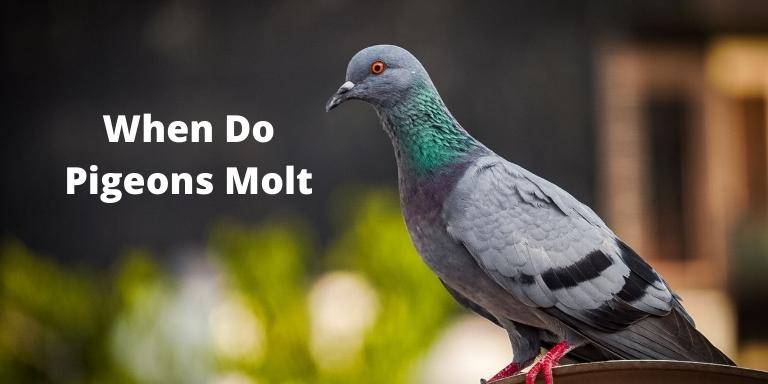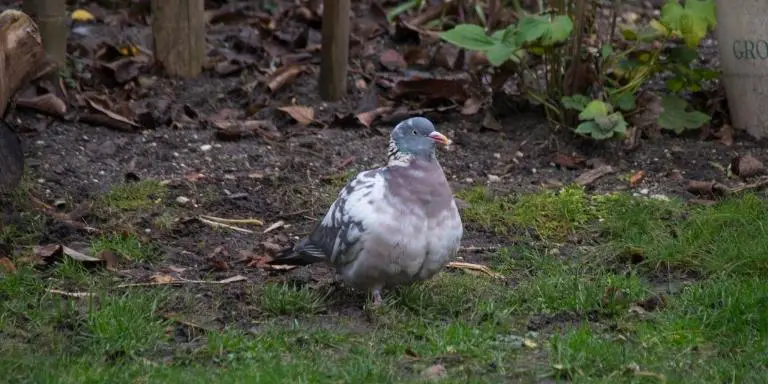Molting is a process in which pigeons shed their worn-out feathers and replace them with new ones. Every year, pigeons molt for a certain period to get new and strong feathers all over their bodies.
If you keep pigeons for the first time, you should know when pigeons molt, how long the process takes, and how to treat your pet during that period. This article is going to answer all of these queries.

When Do Pigeons Molt?
Typically, birds molt in the time between nesting and migrating. First of all, your pigeons have to be in good health to molt.
Pigeons tend to molt when they are paired. Besides, how they have been bred or separated for some time also impacts molting. Exposure to sunlight, changes in hormones, or temperature can also influence pigeons’ molting.
Pigeon Molting Period – Things You Should Know

Pigeons usually molt once a year
Molting is a long process. Pigeons usually molt once a year. Molting happens around late summer to early fall. It begins in August and lasts until mid-November.
Pigeons grow strong and warm feathers during this time, and thus they do not suffer in the winter season.
Pigeons take a pretty long time to molt out completely
Molting is a lengthy process that takes a long time to complete. Pigeons take about three to four months to complete their molting.
The molt begins with the fall of the first feather. A bird can take about 160 to 170 days to molt out properly. However, the tiny feathers continue to molt even after the molting season. The molting process can last up to two years to finish appropriately.
Molting is a stressful process for pigeons
Molting is quite a stressful time for pigeons. They have to shed a lot of plumes and feathers and renew them.
Pigeons will feel more defensive and fearful during this period. Sometimes they become quiet and less active. Their skin becomes exposed to bugs, mosquitoes, and elements, and becomes itchy. Therefore,e you may notice your birds continuously preening themselves.
Severe problems like paratyphoid can also break out just after molting. All these symptoms indicate that molting is quite painful for birds.
Pigeons lose weight when they molt
Molting is an excellent physiological stress for birds. They lose significant weight since they lose all the heavy, worn-out plumage.
They also go through physical distress and serious problems after molting, which can be responsible for weight loss. Besides, growing new feathers requires a lot of energy, which also causes weight loss in pigeons.
Pigeons can get grumpy in their molting period
Growing new plumage is a strenuous activity for a bird, and it takes its toll on the bird’s body. They have to fight with unfamiliar situations for a long time.
Your pigeons can become ill-tempered during the molting period. Screaming or squawking continually can become normal in their daily routine. Besides, most of the pigeons become tired and sleepy during this period.
Although science cannot point out the level of birds’ uneasiness during the molting period, judging their behavior, professionals think they do get grumpy or scared during the molting period. Their mood changes dramatically, and they can show aggressive behavior towards other birds.
Difference Between Pigeon Molting and Plucking
How do you know if your pigeon is molting or plucking? There are noticeable differences between the molting and plucking of a pigeon. When they pluck their feathers, their bare skin will be visible. When they’re molting, they won’t have visible bare skin.
While molting, your pigeons will become defensive, itchy, and ill-tempered while molting and will find dark places to rest up. They will also look tired and less active. Their behavior will make you realize whether they are going through the molting period or not.
On the other hand, pigeons usually pluck their feathers when bored. Sometimes they also try to gain their owner’s attention. In that case, they will only pluck feathers in the owner’s presence.
Things You Can Do to Help Your Pigeon Molt
Ensure the good health of your pigeon
The first thing we have to ensure is the excellent health of the pigeons during the molting season. They have to be healthy enough to endure the pain and complications it faces throughout the process.
Give your birds a good shower twice a week
Let them have a bath freely at least once or twice a week. Adding one tablespoon of Oropharma ideal bath salt to a water bucket will help get a healthy, soft, and shiny plumage.
Provide well-adapted food during the molting period
To ensure that the molting process is going smoothly and protect the bird from any diseases, we should provide well-adapted feed during the period.
Scientifically formulated food like Mutine Plus I.C.+, Mutine Plus I.C.+ Black Label will prevent nutritional deficiencies. The food should contain a minimum of 16% protein for the feathers.
It would help to keep higher legume (thirty percent) content in the food mixture to provide enough protein to your molting pigeons. It would help if you also kept the levels of sulfur amino acids, methionine, and cystine sufficiently high in the food. Mixing brewer’s yeast with feed is also a good idea.
Should you force a pigeon to molt?
If you want to make your bird molt, you can also add Oropharma B-Chol to the drinking water two or three times a week. These are the safest methods to make your pigeons molt, and they will respond very well to these.
However, molting is a natural process of a pigeon’s body. It will eventually happen when the time comes. So it is better not to force molting before the right time.
To ensure a healthy molt, we should allow our pigeons to molt out naturally. Many experiments and research have shown that forcing or training them for molting will slow the process.
Conclusion
These are the essential details about pigeons’ molting period. It is an important phase of a pigeon’s life, and their bodies go through a lot during this time. As you know, when pigeons molt, and what you should do, then help your feathered friends have a smooth & cozy molting period.
You might also be interested in:
